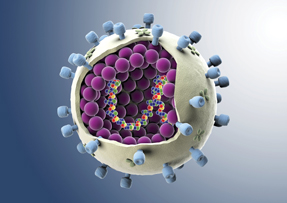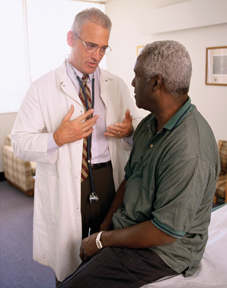Keep up with vaccine recommendations
New vaccines and their recommendations have added complexity and made it tough to stay current. For patients, the extra costs can be prohibitive. Learn how to stay abreast of the requirements and engage patients on the issue.
The perennial effort to vaccinate more adults against influenza and myriad other maladies has become more complex for physicians, with the recent introduction of new vaccines and related recommendations, according to immunization experts.
This flu season, the first quadrivalent influenza vaccines will become available. A new pneumococcal vaccine, pneumococcal conjugate 13 (PCV13), provides an alternative, particularly for immunocompromised patients. Meanwhile, the Advisory Committee on Immunization Practices (ACIP) has also updated recommendations for existing vaccines against pertussis and hepatitis B.

To stay current, Gregory A. Poland, MD, MACP, recommends that doctors post a copy of the ACIP schedule in both the office and patient waiting rooms.
“The adult schedule is now getting complicated enough that many providers, I would say most providers, are not up to date with the most current recommendations,” said Dr. Poland, professor of medicine and infectious diseases at Rochester's Mayo Clinic in Minnesota and chair of ACP's Adult Immunization Committee. “They are complex and continue to change and be updated on a regular basis.”
Adult vaccination has traditionally been an uphill battle, given the time and sometimes the cost involved. For those lacking insurance coverage, some shots can exceed $200 apiece. Persistence is crucial to convey the personal and public health benefit, said Dr. Poland and other vaccine experts.
Already, the human papillomavirus (HPV) vaccine is providing a case study of vaccine success, according to a June article published online in the Journal of Infectious Diseases. Only one-third of U.S. teens ages 13 to 17 have been fully vaccinated, according to officials at the Centers for Disease Control and Prevention (CDC), who authored the analysis. Yet, the study authors found that HPV prevalence has decreased by 56% among those ages 14 to 19 since the vaccine's 2006 introduction.
“I thought that was impressive, to see it that soon,” said John G. Bartlett, MD, MACP, a professor of medicine in the division of infectious diseases at Johns Hopkins University School of Medicine in Baltimore. He added that it is the second vaccine available that also prevents forms of cancer (hepatitis B's vaccine was the first).
New flu vaccines
In recent years, the array of influenza vaccines has become relatively extensive, with options such as a cell culture-derived version that doesn't contain egg proteins or preservatives.
This year, a quadrivalent injection of flu vaccine will be introduced for all ages, along with a four-strain version of the nasal spray that's recommended for patients ages 2 to 49. Along with the two typical A strains, both vaccines also will incorporate two circulating B strains.
A high-dose influenza vaccine also is available, targeted at adults ages 65 and older. The vaccine contains four times the typical amount of antigen and is thus intended to trigger a stronger immune response in older adults, who typically have weakened immunity with increasing age, according to CDC officials.
While the safety profile is similar, it's not yet known if the larger antigen dose combats disease more effectively than the traditional vaccine. A large-scale study, enrolling roughly 26,000 adults ages 65 and older, has been done comparing the two. CDC officials anticipate results by as early as 2015.
For now, ACIP hasn't expressed a vaccine preference for that older age group. But William Schaffner, MD, MACP, a professor at Vanderbilt University in Nashville, Tenn., who is a member of ACP's Adult Immunization Committee and former president of the National Foundation for Infectious Diseases, said that he typically suggests the high-dose vaccine for older patients who are more fragile because of other risk factors, such as a smoking history or a diagnosis of diabetes or heart disease, citing the larger antigen dose.
He also worries that marketing of the new four-strain influenza vaccine will create a boomerang effect if manufacturing can't meet the demand. The three-strain injection also will be available, but patients might view that as second-rate and skip any protection entirely, he said. “That's one of the things that I'm fretting about the most. Patients definitely should receive whatever vaccine is conveniently available,” he said.
More updated recommendations
Another vaccine whose clinical effectiveness is still being assessed is the relatively new pneumococcal vaccine, PCV13.
The PCV13 vaccine received accelerated approval from FDA officials in late 2011 for use in adults ages 50 and older, with the stipulation that postmarketing studies needed to be conducted. To date, ACIP has only recommended its use in adults ages 19 and older who are immunocompromised or have certain other conditions.
PCV13's dosing schedule is complex, said Dr. Poland, who helped to author a summary of the newest vaccines along with updated recommendations published earlier this year in Vaccine. Patients who have never received any pneumococcal vaccine should get the more traditional pneumococcal polysaccharide 23 vaccine (PPSV23) at least eight weeks after PCV13, according to ACIP.
But the dosing regimen is different for adults who have previously received PPSV23. Even Dr. Poland noted that he keeps dosing specifics easily accessible on his smartphone. Helpful apps to keep changing recommendations handy are available from ACP or from the CDC.
An ongoing study in the Netherlands projected to be complete by 2015 will answer the question of the utility of PCV13 in older people, Dr. Bartlett said.
Other recent ACIP recommendations emphasized by Dr. Poland and coauthors in Vaccine include the following:
- Hepatitis B. Given the elevated risk of hepatitis B for diabetic patients, anyone younger than age 60 years should receive the vaccine. The vaccine also should be considered in older patients with diabetes based on their risk factors, such as assisted blood glucose monitoring in group care settings.
- Tdap. To broaden coverage, particularly in light of recent pertussis outbreaks, all adults including those ages 65 and older should get a single booster dose. Plus, women should receive one dose with each pregnancy, ideally at 27 to 36 weeks of gestation, according to ACIP.
Cost and access
The idiosyncrasies of Medicare coverage can make access to some vaccines logistically more difficult for patients. While influenza, pneumonia and hepatitis B fall under Medicare Part B, other more recent vaccines such as herpes zoster and Tdap are covered under Part D's prescription drug benefit.
Dr. Schaffner's recommendation for those vaccines is to write a prescription for the patient to carry to a nearby drugstore where the pharmacist will administer the vaccine. While the prescription is typically not needed, he said, it “usually motivates the patient to actually do it.”
Patients with limited or no insurance coverage should be advised to shop around at nearby drugstores and retail clinics, as availability and price can vary, Dr. Bartlett said.
Once the Affordable Care Act (ACA) is fully implemented next year, ACIP-recommended vaccines will become free of charge for more patients.
The federal law will require private insurers, unless their plan is grandfathered in, to cover recommended vaccines in full, said Phyllis Arthur, who has been monitoring vaccine coverage under ACA for the Biotechnical Industry Organization in Washington, D.C. There will also be no out-of-pocket costs for people insured through health exchanges or for those who benefit from expanded Medicaid coverage in some states, said Ms. Arthur, senior director of vaccines, immunotherapeutics and diagnostics policy at the nonprofit trade organization.
‘Glacial’ compliance
A study published online in early 2013 in Morbidity and Mortality Weekly Report (MMWR) found that 29.5% of women ages 19 to 26 years received at least one dose of the relatively recent HPV vaccine by 2011, compared with 17.1% in 2009. But an MMWR study released in July found that vaccination rates among adolescent girls had not increased from 2011 to 2012.
Compliance with other vaccines also remains relatively static, according to the MMWR's analysis of the 2011 National Health Interview Survey. “In general the rates are increasing, albeit exceedingly slowly, glacially,” Dr. Poland said.
The influenza vaccine, now recommended for all adults, has become relatively common. But younger adults are far less likely to comply. During the 2011-2012 flu season, 64.9% of those ages 65 and older were immunized compared with 28.6% of 18- to 49-year-olds. By comparison, just 15.8% of adults ages 60 and older had received their recommended dose of herpes zoster (shingles) vaccine in 2011, a 1.4% increase from the prior year.
To boost these rates, physicians can play an influential role, starting with standing orders that make vaccination a routine part of office visits, said Dr. Schaffner. A member of the medical team, such as a nurse, should review the schedule with patients to verify that they're up to date, he said.
When questions and worries flare, the doctor should patiently address them while still reiterating the vaccine's protective goal. “Casual recommendations are not remembered by the patient,” Dr. Schaffner said. “You have to keep being a smiling, sustained advocate.”
That advocacy should extend to the practice's clinicians as well, he stressed. Even clinicians can delude themselves into thinking that they'll just stay home if flu-like symptoms develop, said Dr. Schaffner, pointing out that the plan ignores biologic reality.
“Influenza starts to be transmitted the day before you become sick,” he said. “The day before you become sick you are already covering all of your patients with your influenza virus every time you exhale in the vicinity of the patient.”
How then can doctors convince patients? Dr. Poland tells his patients that they are building layers of protection, similar to the cumulative benefits of adding seat belts, air bags and other safety features in a fast-moving vehicle. “You are beginning to surround yourself with things that protect you, and reduce your risk of injury or of hospitalization or death in this case,” he said, by receiving recommended vaccines.
But some patients will always prove resistant, even when cost and other barriers are removed, Dr. Schaffner said. When he encounters such patients, he alerts them that the vaccine discussion is not a one-time conversation.
“Let's have an agreement,” he tells patients. “We are going to continue this conversation the next time I see you, because we all think it's really important in this medical group to have all of our patients protected. So we'll talk about it next time.”




